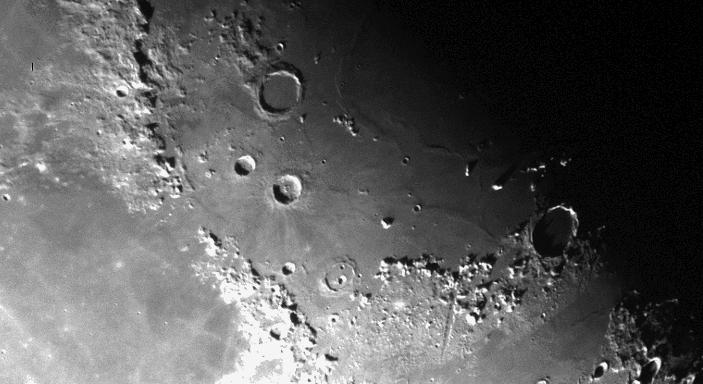Observing the Moon: The Alpine Valley Area
Jack Kramer
As Mae West once said, "Too much of a good thing is wonderful!" And that applies to the Mare Imbrium region of the moon. (Sorry about that, Mae.) We had an article about this Mare some time ago in the newsletter, but it's so full of detail that it's well worth revisiting.
One of the interesting features is the Alpine Valley that slashes through the lowlands of the Alps mountains. Opinions vary as to how the valley was formed. One view is that it began as two fairly parallel rills. A shock caused by a major impact, such as the one that formed the crater Copernicus, might have caused the surface between the two rills to sink. Others suggest a more dramatic origin. Based on how straight and out of place the Valley seems, they feel that a major impact sent a huge projectile hurtling at a low trajectory so that it plowed a furrow through the mountains. And some simply feel that the Alpine Valley is just a large rill.
Running down the center of the Alpine Valley for its full length is a narrow rill, as is clearly shown in the Lunar Orbiter photograph below. It's said to be visible in medium-sized amateur telescopes under ideal observing conditions. But you have to catch it when it's near the terminator and the Sun just illuminates the valley floor. I can't say I've definitely seen this rill with either my 10" reflector or 4" refractor, but I probably didn't catch the moon at just the right phase and under ideal observing conditions. One problem is that small shadows from debris and the valley walls can fool observers into believing we're seeing the rill. This feature will warrant repeated observing under various lighting conditions.

The large-scale CCD image in the adjoining column was taken shortly after first quarter phase when much of Mare Imbrium was in the dark. The lava-filled crater Plato lies just on the terminator.

The Teneriffe Mountains show as little individual peaks of brightness shining through the lunar night. However, regular observers are well aware that these mountains appear very bright at any phase when they're visible.
Published in the August 1996 issue of the NightTimes




